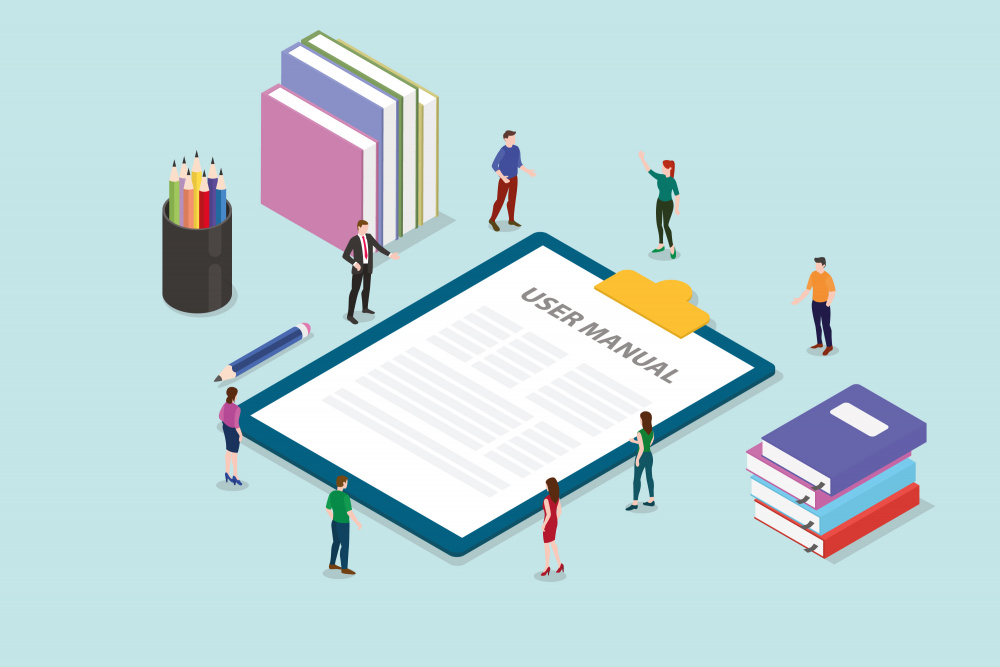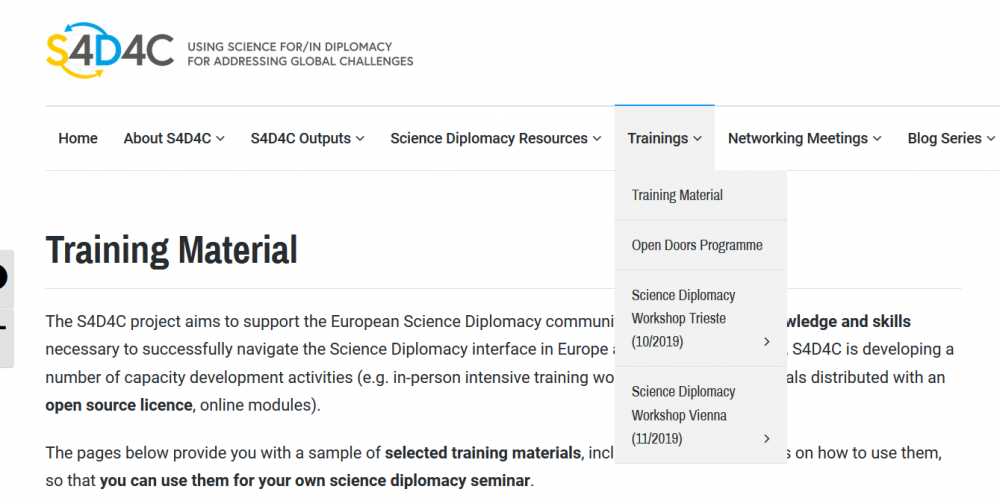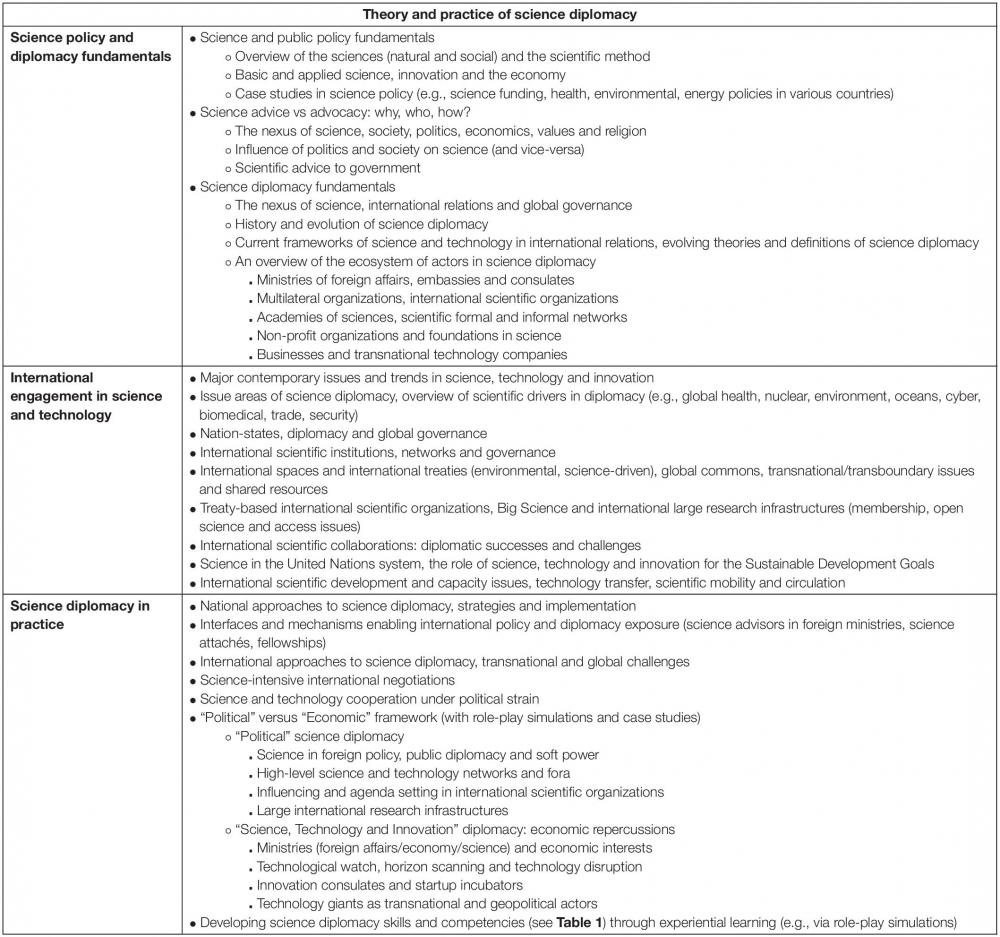6.4 Science Diplomacy Curriculum and Training materials
Science diplomacy lacks a formal educational path and while training opportunities are still limited, they are becoming more frequent. Workshops typically combine different session formats (such topical lectures, simulation exercises, site visits and group work) and provide participants with time and opportunity to network and exchange experiences. The S4D4C team has elaborated a to guide institutions and individuals planning science diplomacy training activities (Toolkit for Trainers) and collected a sample of selected materials with recommendations and advice from S4D4C authors and facilitators: Training Materials. 
 These training materials are categorised along four learning objectives:
These training materials are categorised along four learning objectives:
- Knowledge transfer: resources to provide basic information and theoretical background (e.g. history and definitions of science diplomacy) for trainees.
- Knowledge exchange: instruments to provide participants/trainees with opportunities to present opinions and allow for more in-depth knowledge-sharing (e.g. science diplomacy roundtables and debates).
- Knowledge application: after conveying the basic knowledge and main examples, it is important to apply learning in the most interactive and contextually-relevant way, with experiential activities like simulation games and role-play exercises.
- Knowledge consolidation: Repetition is crucial! It’s useful to combine the review and evaluation process with a reward component – including a little fun. Interactive quizzes and reflection circles ensure a well-rounded and lasting training experience for the participants.
Furthermore, the JRC is pleased to share some further training materials on how to effectively provide scientific evidence to policymaking:
- Curriculum (in English) for 2-day interactive course on Science for Policy
The JRC offers a 2-day professional training course material on assessing science, understanding policymaking processes and gaining insight into the interaction between the different paradigms in which scientists, policymakers and politicians operate. It will help scientists to become reflexive practitioners, mastering the complex task of providing the appropriate knowledge and services with confidence, skill and respect for their scientific and institutional value - 1-hour e-learning module “Science for Policy – how to increase your policy impact”
This course is essential for researchers who would like their research results to have greater policy impact, but may not have the know-how to communicate effectively with policy makers. The Science for Policy e-learning course provides the skills that early to mid-career researchers need to increase the impact of their research results on policy and society at large. - 10 tips for researchers on how to increase their impact on policy
These are JRC’s top tips for researchers and research organisations aiming to achieve policy impact, based on JRC´s practice at the science-policy interface. - ‘Science4Policy’ Competence Framework for researchers
The JRC has seen a need and an added value in consolidating the evidence on what it takes for scientists, in terms of competences, to increase the uptake and impact of their research on policy. The ‘Science4Policy’ competence framework consists of 5 clusters of competences and a total of 27 competences. This is a collective set of competences, that a department or organisation working at the science-policy interface may cover. For each of the 27 competences, the JRC has defined 4 levels of proficiency: foundational, intermediate, advanced and expert
Additional resources are available on the AAAS Science Diplomacy Education website for planning in-person training: https://www.aaas.org/program/center-science-diplomacy/training. But ad-hoc training experiences are not enough. The next step for consolidating science diplomacy education will be mainstreaming into university curricula. Mauduit and Gual Soler (2020) have proposed a sample syllabus for a university course on the theory and practice of science diplomacy.

Table 5. Theory and practice of science diplomacy. Source: JC Mauduit and Gual Soler (2020)
| Find more training activities here: Courses – The Hurford Science Diplomacy Initiative, The Rockefeller University (Link) – Science Diplomacy for Global cooperation, EURAXESS ASEAN R&I Days 2021 (Link) |